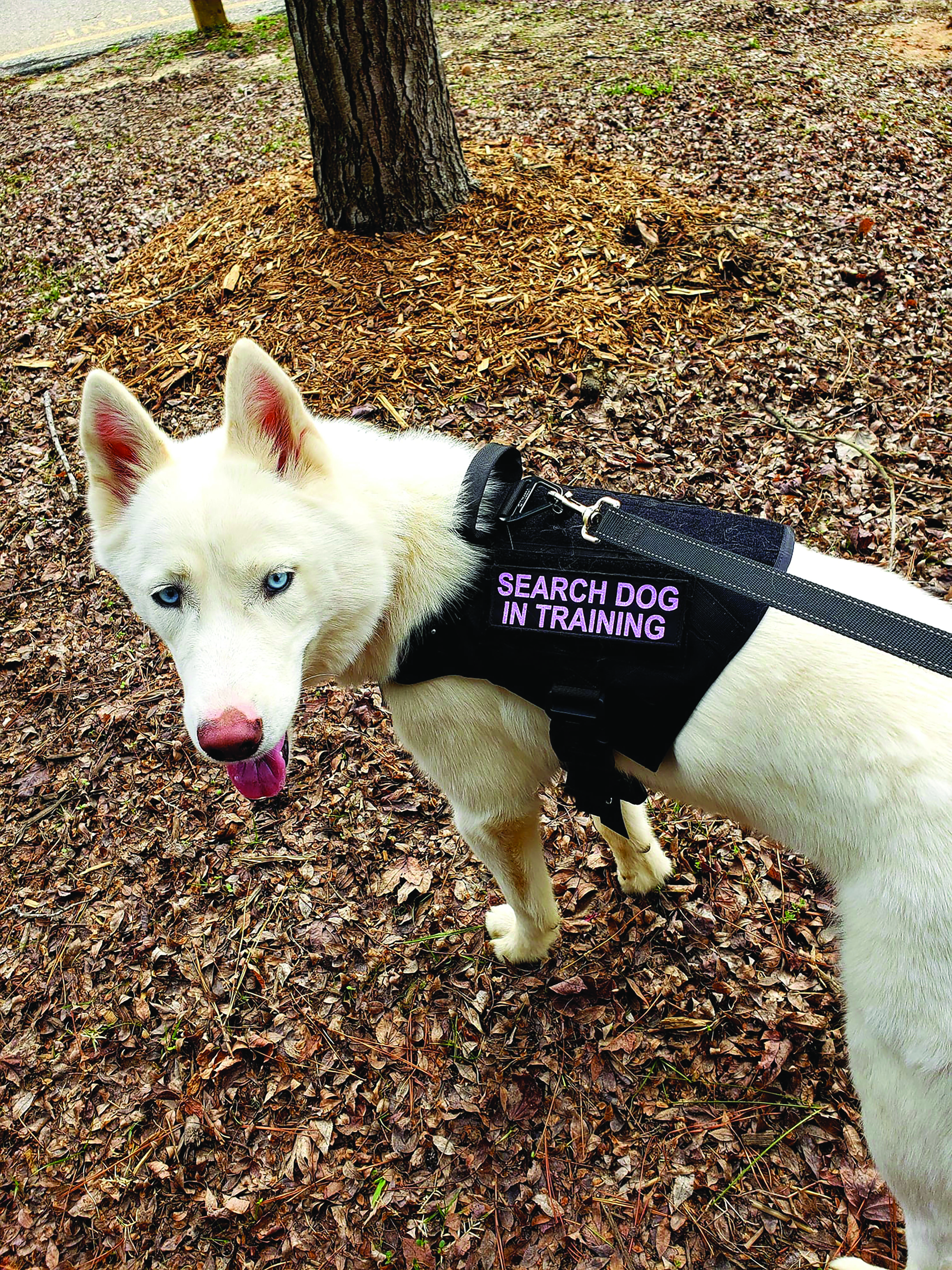At the end of January, I learned that some friends were fostering a small female Chihuahua-mix puppy. She was newly rescued and in my friends’ home for just twenty-four hours before she wriggled out of her harness and took off running into the dark. Too young and too new to the family, the puppy didn’t know her name or her surroundings. Lucky for her, however, my friends didn’t wait before seeking help from a tracking dog and handler trained by the Missing Animal Response (MAR) Network.
Following the handler’s guidance, my friends quickly got the word out on social media with pictures and a description. They distributed flyers in a wide radius from their home and from areas where she was spotted, they created liquid smoke trails leading to their house or nearby traps. Friends and neighbors alike formed search parties and kept an eye out while strolling, running, or driving in the area. This story had a happy ending when, five days later, the puppy turned up on the front stoop of a home in a neighboring subdivision.
The team that helped my friends (Balynda Brown and her dog Bravo) is in high demand. From Raleigh, they travel anywhere they are needed, in-state and elsewhere. But I have good news for Apex readers—North Carolina’s second Missing Animal Response Network team-in-training is none other than our own Erin Eaton and her one-year-old Husky, Kiyaya.
What Does a Tracking Dog, or Tracking Team, Do?
“There are many tools involved in missing pet recovery and a tracking dog is one of those tools,” Eaton said. “The tracking dog is going to narrow down the area where we want you to put feeding stations, cameras, traps, and posters.”
Since January, Eaton and Kiyaya have been engrossed in rigorous, self-paced training with the goal of becoming MAR-certified by the end of 2020. Eaton has completed 10 weeks of her own coursework and, with the invaluable mentorship of other local tracking teams, she and Kiyaya are moving quickly through a sequence of scenarios that can take a dog anywhere from 10 to 18 months to master.
Eaton described the early training as easy “runaway” games that resemble hide-and-seek. “We watch the target handler and target dog duck behind something. I say, ‘Ready…search!’ and we run and find them.” Soon after that, the dog’s acute sense of smell becomes the focus of the training. “We have to know what scent we’re looking for, so we ask pet owners for something the pet has slept on, or a collar or leash, anything they’ve worn. We work toward the dog learning to smell the article and then learning to actually find the scent.”
This is the point at which the training takes on new, but real-life, challenges. For example, Kiyaya won’t see the target team hide and the scent trail must be a few hours old. It makes sense, actually, because typically a day or more will have passed before a pet owner reaches out to a tracking team. As Eaton explained, “Kiyaya really has to think about where this scent is and where this scent goes, and I’m watching her the whole time for certain body postures. When she’s on-scent, her tail is curled and when she’s off-scent it’s straight up. Very subtle ear twitches with her also mean certain things. It’s a lot of work for me to watch her and know.”
Understanding the science of scent is something that fascinates Eaton and she has learned from MAR founder Kat Albrecht, a former law enforcement officer who specialized in crime scene investigation and search-and-rescue, that scent only lasts 14 days. That means that if a pet has been missing for more than 14 days with no sightings, a handler won’t recommend using a dog to track the scent. “Scent reacts differently to dry ground, wet ground, snow, sun, wind…” Eaton said, “and rain actually enhances a scent.” Part of scent training, unfortunately, also involves teaching the dog to track decomposition. For Eaton and other tracking teams, the outcome will not be what the pet owner hoped for but finding the pet and putting it to rest can be essential to closure.
For Eaton and Kiyaya, their training will get steadily more difficult each week until they have mastered the most complex tracking scenarios and obstacles their mentors can devise. Albrecht will then review their progress and performance throughout the course of study and grant certification, something Eaton thinks about with nervous excitement.
K9s on Call Missing Pet Services
Eaton’s interest in becoming a certified tracking team was piqued last summer when a German Shepherd went missing (and was later found safe) near her home. With a family background in veterinary medicine and pet rescue, she eagerly joined the search and handed out flyers as she pushed her toddler, Cameron Rose, in her stroller. She met a professional tracker and learned that other tracking teams charged expensive fees or wouldn’t help because the dog was being sighted within a consistent radius.
With so many ways for a missing animal response team to help, the tracking dog being just one of them, Eaton started thinking, “Why does cost have to stop pet owners from getting the help they need? Why isn’t there a nonprofit that does this?”
Her plans for K9s on Call began crystallizing and her ultimate goal is to be a “full-service nonprofit, and for finances to not be an issue for a pet owner that wants help.” She envisions community outreach through which she can share best practices and dispel the myths that animal control and shelters are the worst outcomes for missing pets. “I firmly believe that a lot of pets euthanized in shelters are lost pets and their owners either have given up or the animals weren’t properly advertised as coming in. There’s miscommunication there, but a lot of [the problem] is funding; our shelters are overstressed. I think we can work with shelters to help [reunite owners with their] lost pets.” Eaton wants to be outside of shelters with a microchip scanner, especially after July Fourth celebrations, in order to intercept lost pets before they end up inside.
Eaton is already helping reunite lost pets with their owners. When someone posts a missing pet on social media, she contacts them and suggests steps they can take immediately. She provides referrals to other tracking teams, is building her arsenal of traps and tools, and guides volunteers in ways to help. Ideally, she hopes to train a deep volunteer pool in MAR practices so that her teams can do anything the pet owner needs.
“Often when you call a missing pet recovery specialist, they say you have to buy a camera, a trap, go to the shelters, and so forth, and people might not have that kind of time or money. I’ll have a team that can do that for you, if you choose. We’ll do social media blasts, go to the shelters, lend you equipment, or we can back you up and help you out by just supporting you. Whatever you need from us. Once Kiyaya graduates, she will be another tool in the bag.”
And Kiyaya will have her paws full, too, training her “big sister.”
Kiyaya was the only all-white puppy in the litter after Eaton’s parents found a pregnant stray Husky. “My parents were pushing me to take one of the puppies and my husband, who doesn’t come from a foster-fail family like I do, said, ‘If you bring another dog into this house, it had better have a job.’ I thought…hmmm…tracking!”
Kiyaya joined Jellybean, Eaton’s pit bull rescue. For 20 years, pit bull advocacy has been her passion and Jellybean, who Eaton estimates is between five and six years old, is in line to start her own training. “Pits are seriously smart and eager to please; she’s going to be easy to train. I understand pit bulls much better than Huskies. Huskies tend to get bored [with training] because it’s not challenging enough for them, but Kiyaya is wickedly smart. I’ll show her something one time and she wants to move on to something else.”
If Your Pet Gets Lost, Know that You Are Not Alone
Missing Animal Response is just one of the reputable organizations that trains tracking specialists, but it’s important to do your homework. Don’t let the panic of the moment draw you into an agreement with an untrained tracker looking to take advantage of your distress, and your money. This is one reason why Eaton’s plan for K9s on Call involves preventing pets from needing tracking team assistance in the first place. Preserving your pet’s scent is something you can do right now, especially if you have more than one dog or cat.
“We recommend pet owners, using a gloved hand, rub a gauze pad over their pet, put the gauze in a baggy, and put the baggy in the freezer. [The scent] stays good for six months, so if your pet goes missing, we have a scent article that is just of your pet. You don’t realize how many woods there are around Apex until you go looking for missing pets. It’s a needle in a haystack.”
Despite our best intentions, sometimes our furry family members get lost. Eaton wants pet owners to know that they’re not alone. “People panic but there are resources who they can call day or night, and somebody will help them. There have been many missing pet cases where I didn’t leave my house. All I did was talk to people, tell them what to do, and support them. And often, their pet was found or came home on its own.”
Eaton started a fundraising effort at the beginning of 2020 to acquire the tools and items she needs for K9s on Call to be full-service. “Traps, canned dog and cat food for bait, slip leashes, trail cameras, and liquid smoke (by the gallon) are all things we need and that don’t come cheap. My husband, Brian, is getting certified in drone-usage so we can add that tool as well.”
To learn more about K9s on Call Missing Pet Services and contribute to Erin Eaton’s nonprofit, visit her Facebook page or reach out to Eaton directly at k9soncallmissingpetservices@gmail.com. To see Kiyaya and Jellybean in action, check out their YouTube channel: Erin, Kiyaya and Jellybean Eaton. And for valuable information about finding missing pets, explore Missing Animal Response Network at missinganimalresponse.com. There are countless ways to help—and Apex pets and their owners will be grateful.








